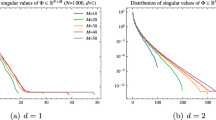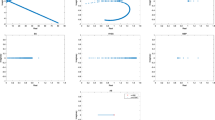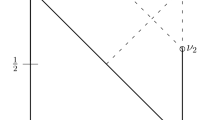Abstract
In this paper, we consider how to accurately solve the nonsymmetric eigenvalue problem for a class of generalized sign regular matrices including extremely ill-conditioned quasi-Cauchy and quasi-Vandermonde matrices. The problem of performing accurate computations with structured matrices is very much a representation problem. We first develop a relatively robust representation (RRR) for this class of matrices by introducing a free parameter, which exceeds an essential threshold, into an indefinite factorization. We then design a new \(O(n^{3})\) algorithm to compute all the eigenvalues of such matrices with high relative accuracy, as warranted by the RRR. Error analysis and numerical experiments are performed to illustrate the high relative accuracy.
Similar content being viewed by others
References
Alfa, A.S., Xue, J., Ye, Q.: Accurate computation of the smallest eigenvalue of a diagonally dominant M-matrix. Math. Comput. 71, 217–236 (2002)
Ando, T.: Totally positive matrices. Linear Algebra Appl. 90, 165–219 (1987)
Dailey, M., Dopico, F.M., Ye, Q.: Relative perturbation theory for diagonally dominant matrices. SIAM J. Matrix Anal. Appl. 35, 1303–1328 (2014)
Dailey, M., Dopico, F.M., Ye, Q.: A new perturbation bound for the LDU factorization of diagonally dominant matrices. SIAM J. Matrix Anal. Appl. 35, 904–930 (2014)
Delgado, J., Peña, J.M.: Accurate computations with collocation matrices of q-Bernstein polynomials. SIAM J. Matrix Anal. Appl. 36, 880–893 (2015)
Demmel, J.: Accurate singular value decompositions of structured matrices. SIAM J. Matrix Anal. Appl. 21, 562–580 (1999)
Demmel, J., Dumitriu, I., Holtz, O., Koev, P.: Accurate and efficient expression evaluation and linear algebra. Acta Numer. 17, 87–145 (2008)
Demmel, J., Gragg, W.: On computing accurate singular values and eigenvalues of acyclic matrices. Linear Algebra Appl. 185, 203–218 (1993)
Demmel, J., Gu, M., Eisenstat, S., Slapničar, I., Veselić, K., Drmač, Z.: Computing the singular value decomposition with high relative accuracy. Linear Algebra Appl. 299, 21–80 (1999)
Demmel, J., Kahan, W.: Accurate singular values of bidiagonal matrices. SIAM J. Sci Stat. Comput. 11, 873–912 (1990)
Demmel, J., Koev, P.: Accurate SVDs of weakly diagonally dominant \(M\)-matrices. Numer. Math. 98, 99–104 (2004)
Demmel, J., Koev, P.: The accuracy and efficient solution of a totally positive generailized Vandermonde linear system. SIAM J. Matrix Anal. Appl. 27, 142–152 (2005)
Dhillon, I.S., Parlett, B.N.: Orthogonal eigenvectors and relative gaps. SIAM J. Matrix Anal. Appl. 25, 858–899 (2004)
Dopico, F.M., Molera, J.M.: Accurate solution of structured linear systems via rank-revealing decompositions. IMA J. Numer. Anal. 32, 1096–1116 (2012)
Dopico, F.M., Molera, J.M., Moro, J.: An orthogonal high relative accuracy algorithm for the symmetric eigenproblem. SIAM J. Matrix Anal. Appl. 25, 301–351 (2003)
Dopico, F.M., Koev, P.: Accurate symmetric rank revealing and eigendecompositions of symmetric structured matrices. SIAM J. Matrix Anal. Appl. 28, 1126–1156 (2006)
Dopico, F.M., Koev, P.: Perturbation theory for the LDU factorization and accurate computations for diagonally dominant matrices. Numer. Math. 119, 337–371 (2011)
Dopico, F.M., Koev, P., Molera, J.M.: Implicit standard Jacobi gives high relative accuracy. Numer. Math. 113, 519–553 (2009)
Dopico, F.M., Pomés, K.: Structured eigenvalue condition numbers for parameterized quasiseparable matrices. Numer. Math. 134, 473–512 (2016)
Gasca, M., Peña, J.M.: Totally positivity, QR factorization and Neville elimination. SIAM J. Matrix Anal. Appl. 14, 1132–1140 (1993)
Gasca, M., Peña, J.M.: A matricial description of Neville elimination with applications to total positivity. Linear Algebra Appl. 202, 33–35 (1994)
Huang, R.: A test and bidiagonal factorization for certain sign regular matrices. Linear Algebra Appl. 438, 1240–1251 (2013)
Huang, R.: A periodic qd-type reduction for computing eigenvalues of structured matrix products to high relative accuracy. J. Sci. Comput. 75, 1229–1261 (2018)
Huang, R.: Accurate solutions of product linear systems associated with rank-structured matrices. J. Comput. Appl. Math. 347, 108–127 (2019)
Huang, R.: Accurate solutions of weighted least squares problems associated with rank-structured matrices. Appl. Numer. Math. 146, 416–435 (2019)
Huang, R.: A qd-type method for computing generalized singular values of BF matrix pairs with sign regularity to high relative accuracy. Math. Comput. 89, 229–252 (2020)
Huang, R., Chu, D.L.: Relative perturbation analysis for eigenvalues and singular values of totally nonpositive matrices. SIAM J. Matrix Anal. Appl. 36, 476–495 (2015)
Huang, R., Chu, D.L.: Computing singular value decompositions of parameterized matrices with total nonpositivity to high relative accuracy. J. Sci. Comput. 71, 682–711 (2017)
Li, C.-K., Mathias, R.: Interlacing inequalities for totally nonnegative matrices. Linear Algebra Appl. 341, 35–44 (2002)
Marco, A., Martínez, J.-J.: Accurate computations with Said–Ball–Vandemonde matrices. Linear Algebra Appl. 432, 2894–2908 (2010)
Parlett, B.N., Dhillon, I.S.: Relatively robust representations of symmetric tridiagonals. Linear Algebra Appl. 309, 121–151 (2000)
Koev, P.: Accurate eigenvalues and SVDs of totally nonnegative matrices. SIAM J. Matrix Anal. Appl. 27, 1–23 (2005)
Koev, P.: Accurate computations with totally nonnegative matrices. SIAM J. Matrix Anal. Appl. 29, 731–751 (2007)
Koev, P.: Accurate eigenvalues and exact zero Jordan blocks of totally nonnegative matrices. Numer. Math. 141, 693–713 (2019)
Koev, P., Dopico, F.M.: Accurate eigenvalues of certain sign regular matrices. Linear Algebra Appl. 424, 435–447 (2007)
Slapničar, I.: Accurate symmetric eigenreduction by a Jacobi method. Ph.D. thesis, Fachbereich mathematik Frenuniversität, Gesamthochschule Hagen, Hagen, Germany (1992)
Veselić, K.: A Jacobi eigenreduction algorithm for definite matrix pairs. Numer. Math. 64, 241–269 (1993)
Watkins, D.S.: Product eigenvalue problems. SIAM Rev. 47, 3–40 (2005)
Ye, Q.: Computing singular values of diagonally dominant matrices to high relative accuracy. Math. Comput. 77, 2195–2230 (2008)
Acknowledgements
The author would like to thank the Editor and the anonymous referees for their valuable comments and suggestions which have helped to improve the overall presentation of the paper.
Author information
Authors and Affiliations
Corresponding author
Additional information
Publisher's Note
Springer Nature remains neutral with regard to jurisdictional claims in published maps and institutional affiliations.
Research supported by the National Natural Science Foundation of China (Grant No. 11871020), the Natural Science Foundation for Distinguished Young Scholars of Hunan Province (Grant No. 2017JJ1025) and the Research Foundation of Education Bureau of Hunan Province (Grant No. 18A198).
Appendix: The Proof of Theorem 2
Appendix: The Proof of Theorem 2
Denote by \(Q_{k,n}\) the set of strictly increasing sequences of k positive integer numbers less than or equal to n. The following result is derived by using a similar argument as that of [27, Theorem 2.6].
Lemma 7
Let \(T=:\mathbb {PM}(T)\in {{\mathbb {R}}}^{n \times n}\) (\(n> 2\)) be nonsingular tridiagonal with \(\mathbb {PM}(T)\ge 0\), and let \(\tilde{T}\in {{\mathbb {R}}}^{n \times n}\) be obtained from T only by replacing one entry x of \(\mathbb {PM}(T)\) with \(\tilde{x}=x(1+\epsilon _{x})\), where \(|\epsilon _{x}|\le \epsilon \) and \(7\epsilon <1\). Then
Proof
Set \(T\in {{\mathbb {R}}}^{n \times n}\) be of the form (3). Then \(\mathrm{det}T=-d_{1}d_{2}\ldots d_{n}\), and trivially, \(|\mathrm{det}\tilde{T}-\mathrm{det}T|\le \frac{\epsilon }{1-\epsilon }|\mathrm{det}T|\). Now consider any minor \(\mathrm{det}T[\mu |\nu ]\) for \(\mu =(\mu _{i}),\nu =(\nu _{i})\in Q_{k,n}\) with \(1\le k \le n-1\). Assume that \(1\le z_{1}<\ldots <z_{r}\le n\) are all indices such that \(\mu _{z_{s}}\ne \nu _{z_{s}}\) for \(s=1,2,\ldots ,r\), and let \(\gamma =\mu {\setminus } \{\mu _{z_{1}},\ldots ,\mu _{z_{r}}\}\). Since \(T=(t_{ij})\in {{\mathbb {R}}}^{n \times n}\) is tridiagonal, we have
where for all \(1\le s\le r\),
and
Remind that only one parameter in \(\mathbb {PM}(T)\) is perturbed. Thus, there is at most one entry \(t_{\mu _{z_{s}},\nu _{z_{s}}}\) of (41) to be perturbed as
For the entry \(t_{n-1,n}\), by considering that \(\alpha _{n-1,n}=\theta +\mathbb {PM}(T)_{n-1,n}\), where \(\theta >0\) is computed in a subtraction-free manner by applying (8) and (9) to \(\mathbb {PM}(T)\), we get that \(|\tilde{\theta }-\theta |\le \frac{2\epsilon }{1-2\epsilon }|\theta |\), thus,
consequently,
In addition, for the minor \(\mathrm{det}T[\gamma ]\) with \(\gamma =(\gamma _{i})\in \mathbb {R}^{k-r}\), the following statements hold.
The case \(\gamma _{k-r}\ne n\). By [27, the equalities (2.12) and (2.13)], considering that only one parameter in \(\mathbb {PM}(T)\) is perturbed, we have
$$\begin{aligned} |\mathrm{det}\tilde{T}[\gamma ]-\mathrm{det}T[\gamma ]|\le \frac{\epsilon }{1-\epsilon }|\mathrm{det}T[\gamma ]|. \end{aligned}$$(44)The case \(\gamma _{k-r}=n\). By using (10) and (7) in a subtraction-free manner,
$$\begin{aligned} {\left\{ \begin{array}{ll}\mathrm{det}T[2:n]=\delta d_{n-1} \prod \nolimits _{t=3}^{n}d_{t-2}\alpha _{t-2,t-1}\beta _{t-1,t-2},\\ \mathrm{det}T[t:n]=\frac{\mathrm{det}T[t-1:n]+\prod \limits _{i=t-1}^{n}d_{i}}{d_{t-2}\beta _{t-1,t-2}\alpha _{t-2,t-1}},~t=3,\ldots ,n,\end{array}\right. } \end{aligned}$$we have
$$\begin{aligned} |\mathrm{det}\tilde{T}[t:n]-\mathrm{det}T[t:n]|\le \frac{2\epsilon }{1-2\epsilon }|\mathrm{det}T[t:n]|,\quad t=2,\ldots ,n. \end{aligned}$$(45)Thus, since
$$\begin{aligned} \mathrm{det}T[\gamma ]=\mathrm{det}T[l:n]\cdot \mathrm{det}T[\gamma '], \quad \gamma '=\gamma \backslash \{l,\ldots ,n\} \end{aligned}$$for some \(n-k+r+1\le l\le n\), we have by (44) and (45) that
$$\begin{aligned} |\mathrm{det}\tilde{T}[\gamma ]-\mathrm{det}T[\gamma ]|\le \frac{3\epsilon }{1-3\epsilon }|\mathrm{det}T[\gamma ]|. \end{aligned}$$(46)
Therefore, combining (40) with (42), (43), (44) and (46), we get that
The result is proved. \(\square \)
Now we are ready to prove Theorem 2.
Proof of Theorem 2
By Lemma 1, A or \(-A\) is similar to \(\bar{A}=:|\mathbb {PM}(A)|\). According to the form (3) of A, denote
Then \(\bar{A}=KTM\), where K and M are TN, and T is SR with signature \((1,\ldots ,1,-1)\). So, by [2, Theorem 3.1], \(\bar{A}\) is SR with signature \((1,\ldots ,1,-1)\). Thus, by [2, Corollary 6.6], all the eigenvalues of \(\bar{A}\), and so A, are real. Moreover, by the Cauchy-Binet identity,
Denote by \(\tilde{\bar{A}}=\tilde{K}\tilde{T}\tilde{M}\) the matrix obtained from \(\bar{A}\) by perturbing one entry of \(|\mathbb {PM}(A)|\). Observe that if the perturbed parameter is from the factor of K or M, then
otherwise, Lemma 7 implies that
where \(\alpha ,\beta \in Q_{k,n}\) with any \(1\le k\le n\). So,
This also means that all the minors of orders less than n of both \(\bar{A}\) and \(\tilde{\bar{A}}\) are nonnegative. Thus, the kth (\(1\le k\le n-1\)) compound matrices \(\mathcal {B}^{(k)}=(b^{(k)}_{ij})\) and \(\tilde{\mathcal {B}}^{(k)}=(\tilde{b}^{(k)}_{ij})\) of \(\bar{A}\) and \(\tilde{\bar{A}}\) are nonnegative satisfying that
Therefore, using a similar argument as that of [27, Theorem 3.4], we conclude that the result is true by considering Lemma 1. \(\square \)
Rights and permissions
About this article
Cite this article
Huang, R. Accurate Eigenvalues of Some Generalized Sign Regular Matrices via Relatively Robust Representations. J Sci Comput 82, 78 (2020). https://doi.org/10.1007/s10915-020-01182-4
Received:
Revised:
Accepted:
Published:
DOI: https://doi.org/10.1007/s10915-020-01182-4
Keywords
- Eigenvalues
- Generalized sign regular matrices
- Relatively robust representations
- High relative accuracy
- Nonsymmetric indefinite matrices




